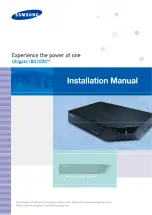
Data network planning
2-84
ptp-450 (July 2014)
Q-in-Q DVLAN (Double-VLAN) Tagging (802.1ad)
PTP modules can be configured with 802.1ad Q-in-Q DVLAN (Double-VLAN) tagging which is a way for an
operator to put an 802.1Q VLAN inside of an 802.1ad VLAN. A nested VLAN, which is the original 802.1Q tag
and a new second 802.1ad tag, allows for bridging of VLAN traffic across a network and segregates the broadcast
domains of 802.1Q VLANs. Q-in-Q can be used with PPPoE and/or NAT.
The 802.1ad standard defines the S-VLAN as the Service Provider VLAN and the C-VLAN as the customer
VLAN. The radio software does 2 layer Q-in-Q whereby the C-VLAN is the 802.1Q tag and the S-VLAN is the
second layer Q tag as shown in
Table 43
Q-in-Q Ethernet frame
Ethernet Header
S-VLAN EthType
0x88a8
C-VLAN EthType
0x8100
IP Data EthType 0x0800
The 802.1ad S-VLAN is the outer VLAN that is configurable on the Configuration => VLAN web page of the
BHM. The Q-in-Q EtherType parameter is configured with a default EtherType of 0x88a8 in addition to four
alternate EtherTypes that can be configured to aid in interoperability with existing networks that use a different
EtherType than the default.
The C-VLAN is the inner VLAN tag, which is the same as 802.1Q. As a top level concept, this operates on the
outermost tag at any given time, either “pushing” a tag on or “popping” a tag off. This means packets will at most
transition from an 802.1Q frame to an 801.ad frame (with a tag “pushed” on) or an untagged 802.1 frame (with the
tag “popped” off. Similarly, for an 802.1ad frame, this can only transition from an 802.1ad frame to an 802.1Q
frame (with the tag “popped” off) since the radio software only supports 2 levels of tags.
Summary of Contents for PTP 450 series
Page 1: ...Cambium PTP 450 User Guide System Release 13 2...
Page 20: ......















































